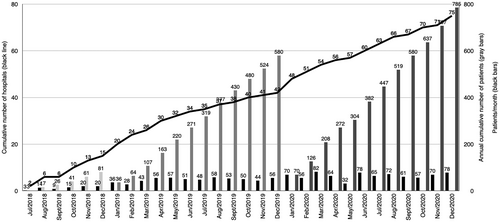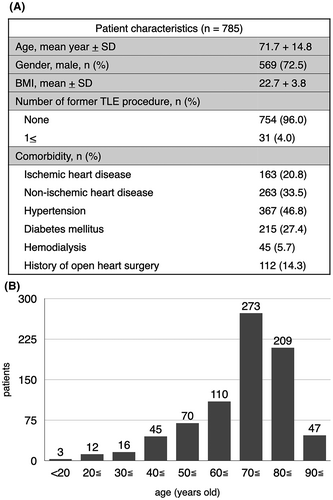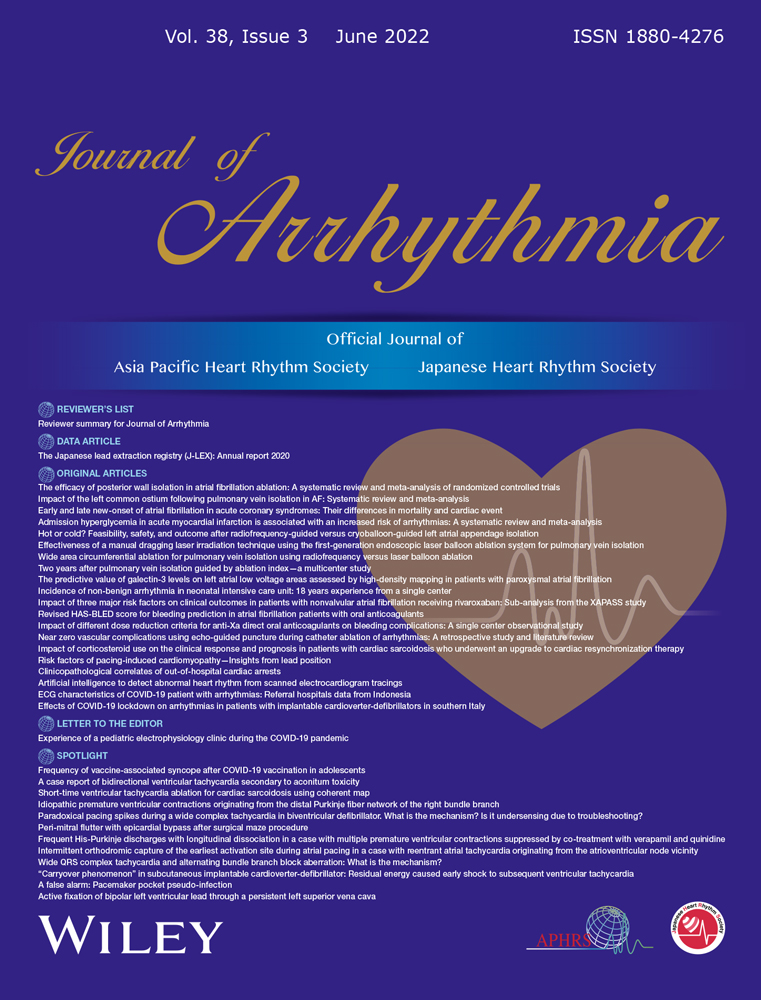The Japanese lead extraction registry (J-LEX): Annual report 2020
Abstract
The Japanese Heart Rhythm Society established a nationwide, mandatory, multi-center, prospective, observational registry of transvenous lead extraction (TLE) named the Japanese lead extraction registry (J-LEX) in 2018. We have published the first annual report of J-LEX with 661 cases from 42 hospitals. The second annual report of J-LEX in 2020 enrolled increased numbers of 785 cases from 75 hospitals. TLE procedure was attempted on patients with an average age of 71.7 years old, male in 72.5% in the hybrid operating room in 57.9%, and in standard OR with a C-arm fluoroscope in 18.7%. The indication of TLE was an infection in 62.8% and the guideline classification was class-I in 67.4% and class-IIa in 23.8%. The average implantation duration of target leads was 7.9 years. Complete removal was achieved in 96.6% of the target leads and clinical success in 98.1% of the patients. Perioperative complications were observed in 7.1% of the patients. One patient died during a TLE operation and the other three patients died in-hospital (cardiac death in one patient and non-cardiac in two patients). Although the annual J-LEX report in 2020 demonstrated an increased number of TLE procedures despite the first pandemic year of coronavirus disease-2019 (COVID-19), perioperative complications increased a little in comparison with J-LEX 2019.
The Japanese Heart Rhythm Society established a nationwide, mandatory, multi-center, prospective, observational registry of transvenous lead extraction (TLE) named the Japanese lead extraction registry (J-LEX) in 2018. This registration has been conducted according to the methods of the previously published design paper,1 under the approval from the Institutional Review Board (IRB) of the National Cardiovascular Center (M29-146, February 23, 2018), along with the IRBs of all participating hospitals. We have published the first annual report of J-LEX with 661 cases from 42 hospitals.2 The second annual report of J-LEX in 2020 enrolled increased numbers of 785 cases from 75 hospitals despite the coronavirus disease-2019 (COVID-19) pandemic year (Figure 1). TLE procedure was attempted on the patients from January to December in 2020 with an average age of 71.7 years old, male in 72.5%, and body mass index (BMI) smaller than previous reports from western countries3, 4 (Figure 2). The TLE procedure was performed in a hybrid operating room (HBOR) in 57.9%, in the standard operating room with a C-arm fluoroscope in 18.7%, and in a catheter laboratory in 23.4% (Figure 3A). The method of anesthesia was mainly general anesthesia in 75.7% (Figure 3B). The indication of TLE was an infection in 62.8% and the guideline classification5 was class-I in 67.4%, class-IIa in 23.8%, and class-IIb in 8.8% (Figure 3C). The average number of extracted leads per patient was 1.9 (Figure 3D). The type of extracted lead was pacemaker lead in 80.3%, implantable cardioverter-defibrillator lead in 14.8%, and cardiac resynchronization left ventricular lead in 4.7% (Table 1A). The average implantation duration of target leads was 7.9 ± 7.0 years (Table 1B). Multiple methods of lead extraction were used in many cases: laser sheaths (GlideLight, Philips) were used for 67.5% of leads, rotational mechanical sheaths (Evolution RL, Cook Medical) for 26.2% of leads, and mechanical sheaths (Cook Medical) for 16.6% of leads. Also, snaring techniques were used for 15.2% of the leads. Complete removal means all parts of the lead(s) were extracted was achieved in 96.6% of the target leads and clinical success means complete removal or partial removal (retention of the small lead material less than 4 cm) without a negative impact on clinical goal was obtained in 98.1% of the patients (Table 1E). Perioperative complications were observed in 7.1% of the patients (Table 1D). Open surgical procedures were performed for lead remnants, infected vegetations, or bleeding complications for 28 leads. One patient died during a TLE operation and the other three patients died in-hospital (cardiac death in one patient and non-cardiac in two patients).



| (A) Extracted leads (n = 1511) | ||
| n | % | |
| Pacemaker, unipolar | 33 | 2.2 |
| Pacemaker, bipolar | 1167 | 77.2 |
| Pacemaker, VDD | 14 | 0.9 |
| ICD, single coil | 116 | 7.7 |
| ICD, dual coil | 103 | 6.8 |
| ICD, patch | 0 | 0.0 |
| ICD, only coil | 4 | 0.3 |
| LV, unipolar | 3 | 0.2 |
| LV, bipolar | 17 | 1.1 |
| LV, quadripolar | 52 | 3.4 |
| LV, active fixation | 0 | 0.0 |
| Other | 2 | 0.1 |
| Unknown | 0 | 0.0 |
| (B) Lead age (n = 1472) | ||
| 7.9 ± 7.0 years | ||
| (C) Lead status (n = 1511) | ||
| n | % | |
| Non-recall, function | 1214 | 80.3 |
| Non-recall, non-function | 269 | 17.8 |
| Recall, function | 8 | 0.5 |
| Recall, non-function | 20 | 1.3 |
| (D) Methods of lead extraction (n = 1511) | ||
| n | % | |
| Simple traction | 395 | 26.1 |
| Locking stylet | 1122 | 74.3 |
| Mechanical sheath | 250 | 16.6 |
| Laser sheath | 1020 | 67.5 |
| Rotational mechanical sheath | 396 | 26.2 |
| Other power sheath | 9 | 0.6 |
| Snare | 230 | 15.2 |
| Surgical (open chest) | 4 | 0.3 |
| Surgical (open heart) | 24 | 1.6 |
| (E) Outcome of lead extraction | ||
| Per lead (n = 1511) | n | % |
| Complete removal | 1460 | 96.6 |
| Partial removal | 33 | 2.2 |
| Unsuccess | 17 | 1.1 |
| Suspended by complication | 1 | 0.1 |
| Per patient (n = 785) | n | % |
| Clinical success | 770 | 98.1 |
| Complete success | 738 | 94.0 |
| Partial success | 32 | 4.1 |
| Failure | 14 | 1.8 |
| Unknown | 1 | 0.1 |
| (F) Complications (n = 785) | ||
| n | % | |
| Perioperative complication | 55 | 7.0 |
| Pericardial effusion | 8 | 1.0 |
| Cardiac tamponade | 13 | 1.7 |
| No intervention | 0 | 0.0 |
| Pericardiocentesis | 3 | 0.4 |
| Surgical repair | 10 | 1.3 |
| Hemothorax | 3 | 0.4 |
| No intervention | 0 | 0.0 |
| Intervention | 3 | 0.4 |
| Other bleeding | 20 | 2.6 |
| No BTF | 7 | 0.9 |
| BTF | 13 | 1.7 |
| AV fistula | 0 | 0.0 |
| Pulmonary embolism | 1 | 0.1 |
| No intervention | 1 | 0.1 |
| Intervention | 0 | 0.0 |
| Other | 10 | 1.3 |
| Perioperative death | 1 | 0.1 |
| In-hospital death | 3 | 0.4 |
| Cardiac | 1 | 0.1 |
| Non-cardiac | 2 | 0.3 |
- Abbreviations: AV fistula, atrioventricular fistula; BTF, blood transfusion; ICD, implantable cardioverter-defibrillator; LV, left ventricle.
Although the annual J-LEX report in 2020 demonstrated an increased number of TLE procedures despite the first pandemic year of COVID-19 and acceptable clinical outcomes, perioperative complications increased a little in comparison with J-LEX 2019.
ACKNOWLEDGMENTS
The authors are grateful for the contributions of all investigators, and Akiko Maruta, Misato Tao for data management in the J-LEX registry.
CONFLICT OF INTEREST
Morio Shoda: Speaker honorarium from Medtronic Japan, and financial endowments to our clinical research division from Biotronik Japan, Medtronic Japan, Boston Scientific Japan, and Abbott Japan.
Kengo Kusano: Speaker honoraria from Daiichi-Sankyo, Japan, Bristol-Myers Squibb, Biotronik Japan, and Medtronic Japan, and research grants from Medtronic Japan and EP-CRSU Co., Ltd.
Masahiko Goya: Speaker honoraria from Japan Lifeline, Medtronic Japan, Johnson and Johnson, and Bayer.
Nobuhiro Nishii: Speaker honoraria from Medtronic Japan, Boston Scientific Japan, and financial endowments to our clinical research division from Medtronic Japan.
Michio Nagashima: Speaker honoraria from Medtronic Japan and Biotronik Japan.
Akihiko Nogami: Speaker honoraria from Abbott and Daiichi-Sankyo; an endowment from Medtronic and DVX.
Wataru Shimizu: Speaker honoraria from Daiichi-Sankyo, Boehringer-Ingelheim, Ono Pharmaceutical, Bayer, and Bristol-Myers Squibb, and research grants from Abbott Japan, Japan Lifeline, Boehringer-Ingelheim, and Daiichi-Sankyo.




